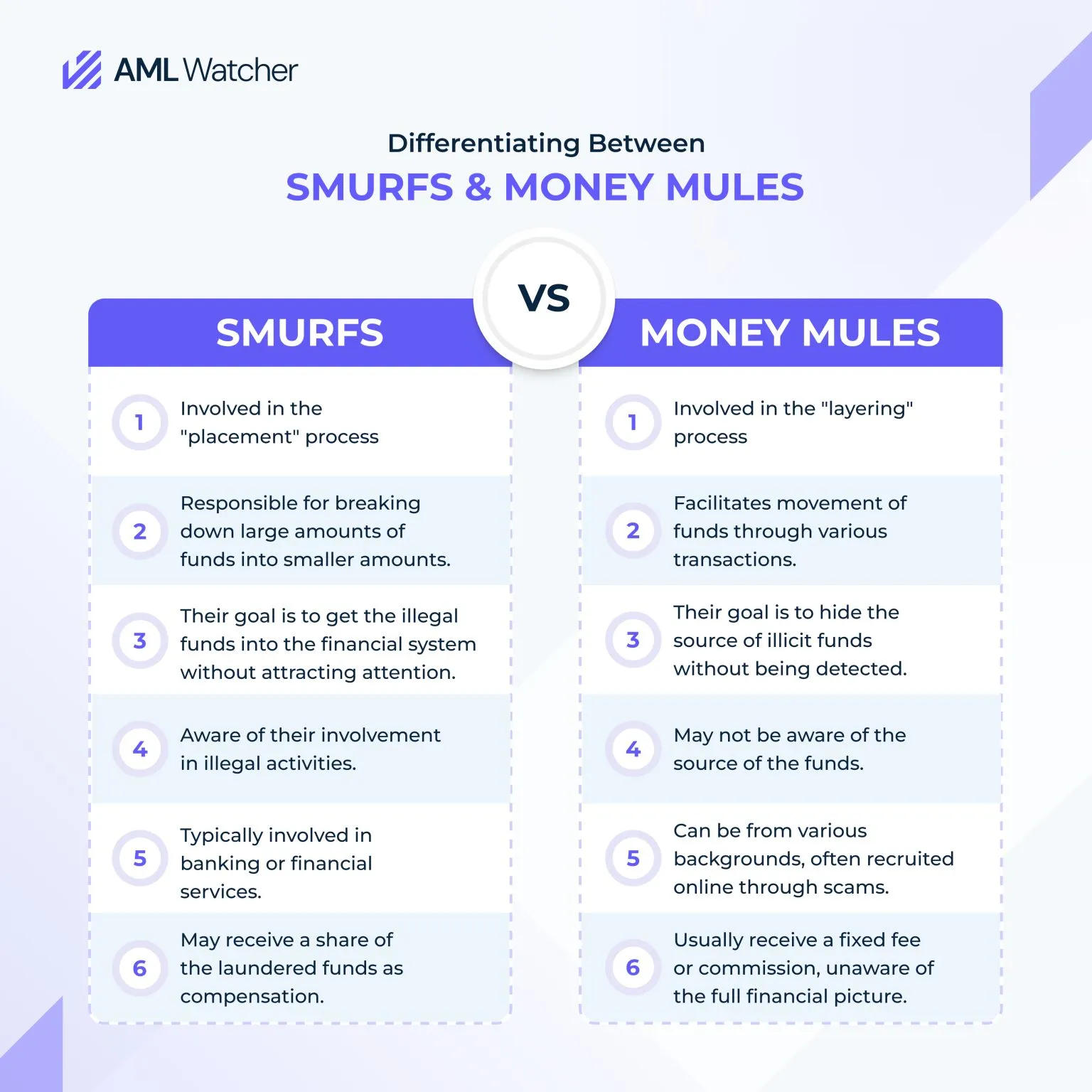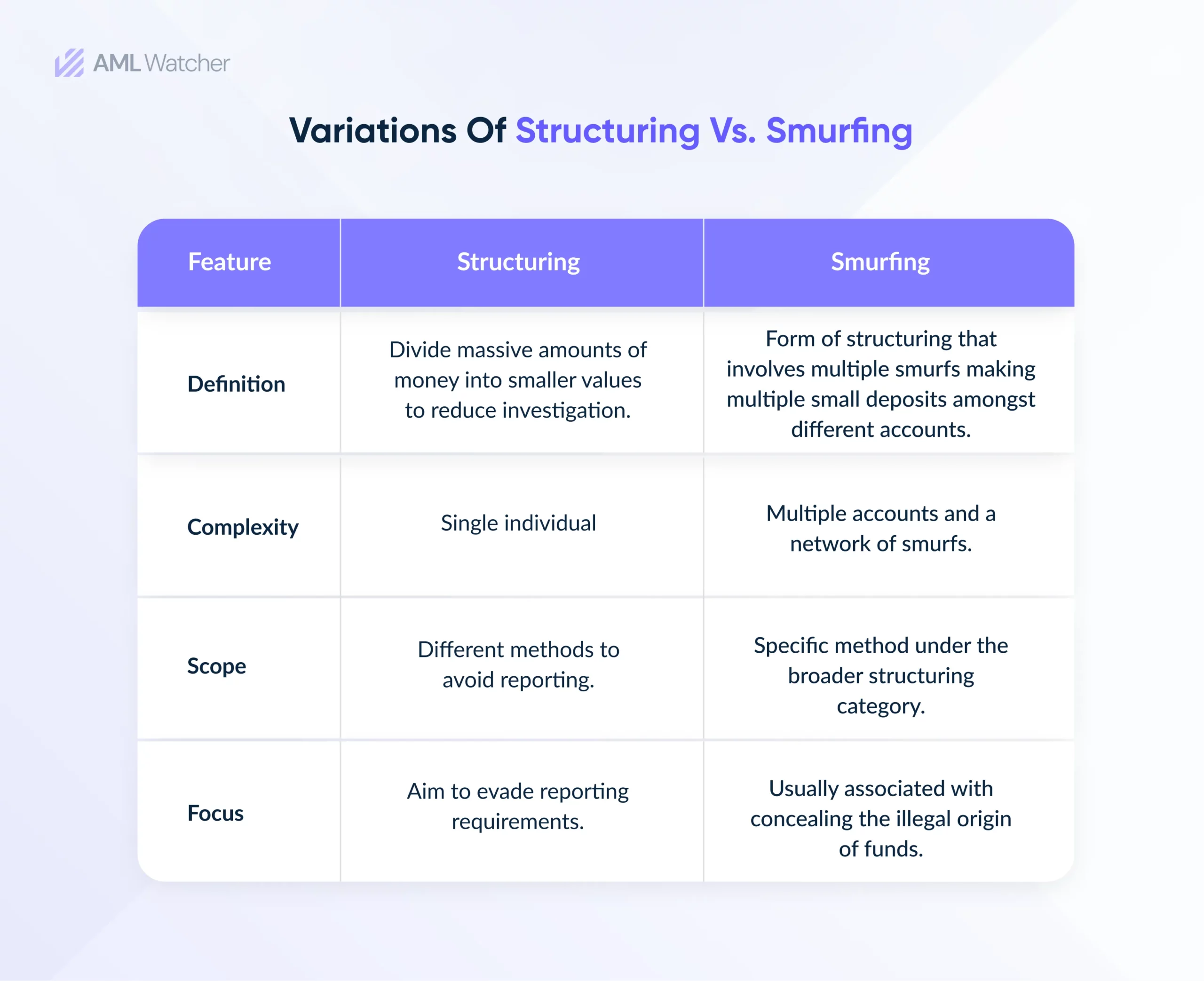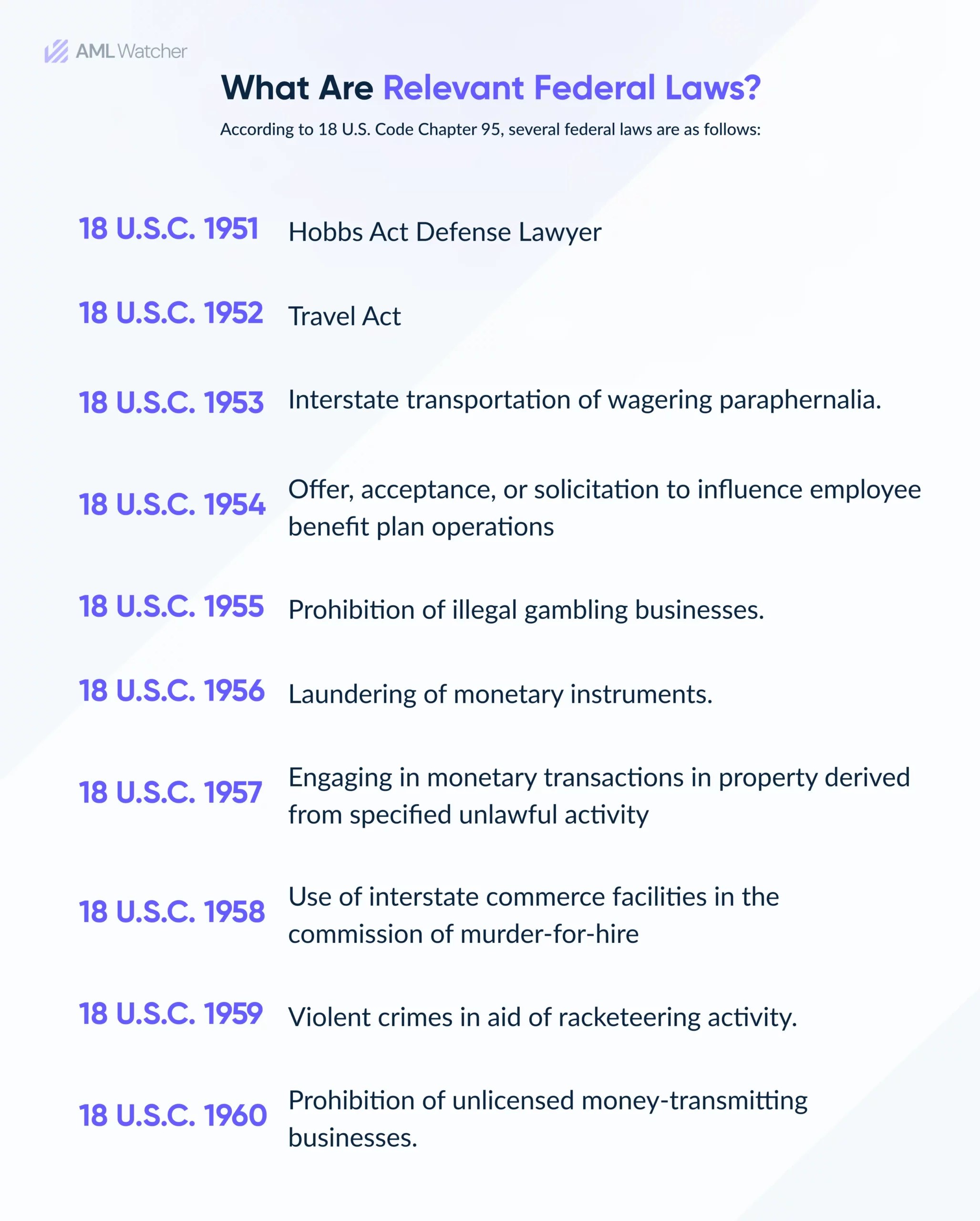
Structuring vs Smurfing: Sneaky Money Laundering Techniques
Money laundering, the process of hiding the illegal origin of funds, blooms in the darkness. In 2020, 64,565 cases were filed in the US Sentencing Commission.
The rising number of money laundering cases is alarming for regulatory bodies. If not controlled, it can damage the entire economy.
Let’s compare two famous practices, structuring vs smurfing, which aim to evade detection but differ in their complexities and methods. Structuring meaning in money laundering is when launderers split huge financial transactions into small parts.
However, smurfing deposits money in multiple accounts to avoid investigation.
This guide highlights the deceptive practices of launderers and helps you differentiate between smurfing and structuring.
What is Structuring?
Structuring in money laundering is a broader concept that involves manipulating finance, including withdrawal, exchange, and deposits, to escape the investigation process.
It’s a strategy of breaking down financial transactions into a certain value that is less than the reporting threshold to evade scrutiny.
Structuring Attributes
- Involves transfers, deposits, and withdrawals
- Broader concept than smurfing
- Manipulation of different types of financial transactions
What is Smurfing?
Smurfing money laundering is a common money laundering process that breaks down huge amounts of illegally obtained cash into smaller transactions. Then, smurf deposits this money into multiple bank accounts to avoid being investigated by law enforcement agencies and financial institutions.
Smurfing Attributes
- Usage of multiple financial institutions and bank accounts
- Multiple small bank transactions
- Avoid investigations about large transactions
What is Smurf – Distinctive Breed of Money Laundering
Smurfing is usually involved in the money laundering process, a famous type of AML structuring. It is a crime with severe legal consequences. However, regulatory bodies and authorities are making strategies to identify and prevent smurfing.
Hypothetical Illustration of Smurfing
It will be easy if we understand smurfing through an example. Let’s say that a Smurf in New York owes $9000 to a London scammer, and a London trader has borrowed a New York supplier $9000. This is what follows next.
- The London smurfer goes to a bank, deposits $9000, and instructs the New York middleman to transfer money to his bank.
- The London banker who works with New York criminals gives instructions to deposit $9000 in the New York smurfer’s bank account.
- Next, the London banker transfers $9000 to the London criminal account.
- The smurfers never directly send illegal amounts of money. Only bankers are involved in these procedures; if caught, they face serious consequences.
Cuckoo Smurfing – A Famous Concept
“Cuckoo smurfing” is a famous type of smurfing in which smurfs usually target the individual’s bank accounts, expect to receive overseas funds, split huge transactions into smaller, less-than-thresholds, and avoid reporting to regulatory bodies in Australia.
Scammers fulfill their illicit goals through money transfer agents and layer money as it comes through any credible source. This process is usually observed to avoid paying taxes.
Smurfs deposit their money into any individual bank account and execute this process with the help of any bank employee. They layer this illegal money by purchasing any currency or investing it in a famous project.
Fundamentals of Cuckoo Smurfing
Following are essential elements of Cuckoo smurfing:
- Structuring: To avoid the reporting threshold, funds are divided into smaller transactions.
- Cross-Border Transactions: The beneficiary and transferer are in two different regions.
- Involvement of Smurfs: Different Smurfs deposit cash in the bank account of a targeted individual.
- Illegal Money: Cash obtained from unlawful activities.
- No Physical Transfer: No proof of physical money transfer in cross-border transactions.
Did You Know?
Australian Exporters, Australian Expatriates, International Investors, International Students in Australia and People Wish to Settle in Australia are most vulnerable to Cuckoo Smurfing.
Real-Time Case Study of Cuckoo Smurfing
Under section 563A of the Criminal Code Compilation Act 1913, an individual was declared guilty of 4 counts of property laundering under charges laid by the Western Australia Police Force (WAPF) – money laundering squad.
In July 2020, the WAPF and Fintel Alliance conducted a joint intelligence operation investigating suspected cuckoo smurfing activity in WA.
From September 2019 to 2020, the AUSTRAC financial intelligence force suspected individuals of making low-value and multiple cash deposits in the Perth region.
After investigation, it has been estimated that over $430,000 has been smurfed through an overseas residence. A close relative did this to him, and an overseas member sent directions through a secure message, including instructions on depositing a certain amount of cash into a 3rd party account at different locations in Perth.
IDMs- intelligent deposit machines were used in this scenario that issued bank cards through third party accounts. However, its branch services were used due to certain limitations on IDM that prevented the individual from conducting huge deposits at the decided location.
Consequences on Financial Institutions
Structuring and smurfing are both illegal practices that significantly threaten financial institutions. Here are a few ways in which they impact these institutions.
Reputational Damage
A single case of smurfing or structuring can affect company goodwill. Since investors and customers don’t tolerate financial companies involved in illegal practices, the impact of reputational damage can’t be ignored.
Risks to Financial Institutions
Financial companies face the following risks if involved in structuring and smurfing practices:
- Engaging in these activities leads to regulatory consequences, including criminal charges.
- Direct financial loss can happen through chargebacks and fraudulent transactions.
- Increased compliance efforts to identify and prevent strains on resources and effects on daily operations.
Regulatory Implications
Financial firms use AML and CTF to reduce crimes. However, non-compliance with these forces leads to reputational damage and severe penalties.
How to Detect and Prevent Structuring vs. Smurfing?
Structuring and smurfing are two famous methods used to fulfill illegal means. AML Compliance is an effective measure that can be used in the following manner:
- To understand the risk profile, Customer Due Diligence (CDD) is required to recognize and verify client information.
- Implement transaction monitoring to scrutinize transaction patterns for any unusual activity.
- File a report to the relevant regulatory authority if any suspicious activity is detected through SARs.
- Train employees to ensure that staff knows AML regulations and can quickly recognize red flags.
In 2023, the revenue from anti-money laundering software was $1.77 billion, which is expected to increase in the coming future. This figure highlights the increasing demand for anti-money laundering software, and AML Watcher is one of them.
AML Watcher, along with strategic partners including regulatory, law enforcement bodies, and financial institutions, helps businesses identify and prevent economic crimes. .
Get in touch with our compliance geeks to smartly manage AML risks.
Book Free DemoWe are here to consult you
Switch to AML Watcher today and reduce your current AML cost by 50% - no questions asked.
- Find right product and pricing for your business
- Get your current solution provider audit & minimise your changeover risk
- Gain expert insights with quick response time to your queries






